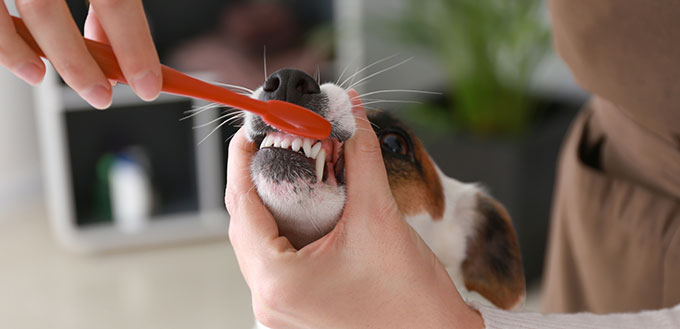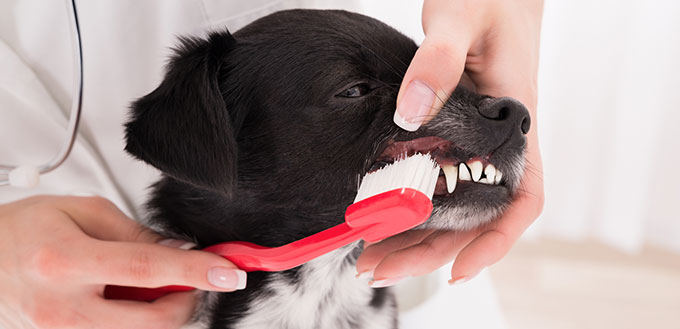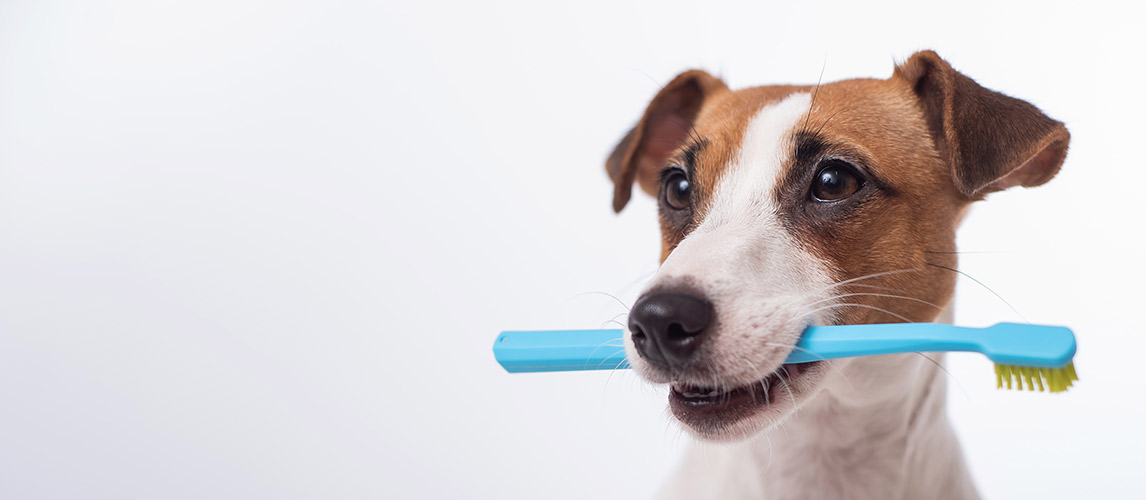Unfortunately, a huge percentage of cats and dogs over six years of age suffer from dental disease. As bacteria, food, and saliva combine, they form plaque. The good news is that plaque can be removed by chewing and brushing. However, the bad news is that if you allow plaque on dog teeth to remain there, over time it will react with minerals to form tartar – a yellow coating that causes discoloration.
A tartar buildup in your dog’s mouth won’t only look unpleasant, there is even a risk that, if the tartar spreads under the gum and over the tooth, gum inflammation commonly referred to as gingivitis could arise. Although your puppy won’t be in pain with gingivitis, this non-destructive type of periodontal disease could lead to permanent infection of the gums. Accordingly, something must be done to combat tartar’s destructive effects. Whether you’re here as your dog suffers from plaque built-up or are learning to prevent plaque from forming on your dog’s teeth, read on as we guide you through how to clean tartar from a dog’s teeth.
Brush Your Dog’s Teeth
For obvious reasons, brushing your dog’s teeth is recommended. Yet we’d all do it if brushing our dog’s teeth and gums was that simple, right? Some dogs simply cannot take to even having a toothbrush near them – never mind in their mouth! Thankfully, the invention of finger brushes such as H&H Pets Professional Dog Toothbrush has saved many a dog owner from insanity. Cleverly designed to fit over your finger, a finger toothbrush contains rubber bristles that will remove plaque and tartar – subject to the condition that you brush your dog’s teeth properly, that is! Our advice on cleaning dog’s teeth properly is detailed below:
Gather your tools together: For tooth brushing to commence, you must have by your side a finger toothbrush (although a “human” brush will also do) and dog toothpaste. Try as you might to save a bit of cash by bringing out your own toothpaste, human toothpaste is unsuitable to use on a dog due to the vast majority containing Xylitol. This artificial sweetener is toxic to dogs if swallowed and may cause their blood sugar to rapidly drop and result in potential liver damage. What you would save in cash is just not worth the colossal risk.
Brushing away: Exactly like how you brush your own teeth, it’s important to brush your dog’s teeth in a circular motion. Regarding pressure, ensure that you press down harder on the molars while brushing whilst lessening the pressure on the gums. That’s all there is to know, really!
Switch Your Dog to a Dental Diet
Whether you choose to go down the expensive route of purchasing a medically-approved dental diet for your dog to switch over to or simply swap their kibble from wet to dry, diets that cater towards dental health are fantastic for removing dog tartar buildup. To prevent periodontal disease from occurring, these diets contain low amounts of protein and calcium in order to impede plaque and tartar from mineralizing. Furthermore, the kibbles in dental diets are specially shaped to engender an abrasive effect on the teeth as dogs chew to remove plaque and tartar. Although dry food won’t do this as effectively, this type of food is a cheap alternative to dental diets as well.
Related Post: Dry Dog Food
The addition of the inorganic compound sodium polyphosphate to bags of dental diet food also plays a major role in preventing periodontal disease. Manufacturers include sodium polyphosphates so they can be released into a dog’s oral cavity to trap the calcium, which is largely responsible for converting plaque into calculus. Besides tooth brushing, dental diets are the next best thing.
Dental Chews Provide a Tasty Yet Healthy Solution
If you want your pup to have a good time while simultaneously improving their dental health, a chew a day is the way to do it! Scraping the surface of the teeth containing plaque and tartar with a dental chew will work wonders with concern to dog tartar removal. Plus, your dog will be ecstatic when “chew time” rolls around each day! Personally, our favorite choice of dental chew is Greenies Dental Dog Chews, with the chewy texture of these treats operating as a brush, successfully removing tartar from your dog’s teeth. However, for a dental chew to work properly, it is imperative that your dog chews on both sides of the mouth against the surface of every molar or the tartar won’t be removed.
Can’t Stand Your Dog’s Bad Breath Any Longer? Invest in Water Additives
Although water additives cannot reverse the symptoms of gingivitis that your pet already has, they can impede the speedy growth of bacteria. Besides, you’ll be relieved to discover that water additives even help combat bad breath – thank goodness for that! Advocates of dog water additives state that the best thing about them – excluding their success at eliminating their dogs’ bad breath, of course – is their ability to be added to a dog’s water bowl. For dogs who detest when their owners attempt to take care of their teeth by brushing, this method is a much less invasive alternative.
Dental Sprays Keep the Plaque Away
Using a dental spray is a fairly inexpensive way for cleaning plaque and tartar from dog teeth. These sprays operate so effectively thanks to enzymes that act as catalysts in cutting down plaque and tartar build up. Among our personal favorite dental sprays is Pets are Kids Too’s Premium Pet Dental Spray, which contains antiseptic properties to fight against infection.
In order to apply a dental spray effectively, you should do so around half an hour either before or after your dog will eat or has eaten. Directly spraying the dental spray onto your dog’s tongue, the enzymes within it will mix with the saliva, softening the layers of tartar which can later be removed by brushing.
If All Else Fails, Take Your Dog to the Vet
Sometimes, no matter how many home remedies you try out, the tartar remains. Turning to a veterinary professional is always the best way to remove tartar. Using a dental drill, a dental professional will scale off the tartar from large teeth and polish them up afterwards. Although this step is by far the most expensive, there really is no better and safer way to remove substantial amounts of tartar.
Now with this wealth of information and top tips at your disposal, you can begin to follow these six simple steps that will help you clean tartar from your dog’s teeth. Happy cleaning – and, if you need any more advice, then you know how to find us.
Sources:
- Jan Bellows, DVM, Plaque and Tartar Prevention in Dogs, VCA
- Pet Dental Care, Best Friends Animal Society
Note: The advice provided in this post is intended for informational purposes and does not constitute medical advice regarding pets. For an accurate diagnosis of your pet's condition, please make an appointment with your vet.








